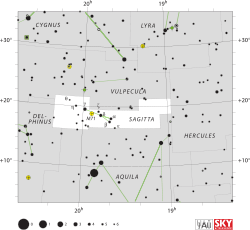15 Sagittae

| |
| Observation data Epoch J2000.0 Equinox J2000.0 | |
|---|---|
| Constellation | Sagitta |
| Right ascension | 20h 04m 06.22s |
| Declination | 17° 04′ 12.6″ |
| Apparent magnitude (V) | 5.8 |
| Characteristics | |
| Spectral type | G0V[1] |
| Astrometry | |
| Radial velocity (Rv) | 5.39 km/s |
| Parallax (π) | 56.28 mas |
| Distance | 57.7 ly (17.69 pc) |
| Details | |
| Mass | 1.08 ± 0.04[1] M☉ |
| Radius | 1.115 ± 0.021[1] R☉ |
| Luminosity | 1.338 ± 0.032[1] L☉ |
| Surface gravity (log g) | 4.42 ± 0.06[1] cgs |
| Temperature | 5883 ± 59[1] K |
| Metallicity [Fe/H] | 0.05 ± 0.07[1] dex |
| Rotation | 17.5 ± 2.3[1] |
| Rotational velocity (v sin i) | 4.42 ± 0.06[1] km/s |
| Age | 2.5 ± 1.8[1] Gyr |
| Other designations | |
HR 7672, Gl 779, HIP 98819, HD 190406, BD+16 4121, SAO 105635, LHS 3515, LTT 15872, LFT 1517, Wolf 866 | |
| Database references | |
| SIMBAD | data |
15 Sagittae (15 Sge) is a 6th magnitude star in the constellation Sagitta. Considered a solar analog, it was the target of the first radial velocity survey from Lick Observatory, which found a drift due to a companion;[2] In 2002, the cause of this was found to be brown dwarf companion B via direct imaging.
15 Sagittae B
15 Sagittae B is a high-mass substellar L dwarf of spectral class L4 ± 1.5, only a few Jupiter masses below the limit for stars, in a long-period orbit around the primary star. Imaged by the Keck telescope, was the first brown dwarf candidate orbiting a sun-like star detected via imaging and is currently the only known companion brown dwarf which both has a significant radial velocity trend on the primary that has also been imaged.
The brown dwarf was originally thought to have a semi-major axis of 14 AU and a circular orbit viewed from pole-on,[3] but ten more years of observations found that the brown dwarf's orbit is viewed from nearly edge-on, is significantly eccentric and appeared to be moving in a circular orbit when first discovered, but is now approaching the primary as viewed from Earth.[1]
| Companion | Mass (MJ) |
Radius (RJ) |
Luminosity (L☉) |
Temperature (K) |
Orbital period (y) |
Semimajor axis (AU) |
Orbital ecc. |
Inclination (°) |
Discovery year |
|---|---|---|---|---|---|---|---|---|---|
| B | 68.7+2.4 −3.1 | 1.0 ± 0.4 | 0.000075 ± 0.000016 | 1510-1850 | 73.3+2.2 −3.9 | 18.3+0.4 −0.5 | 0.50 ± 0.01 | 97.3 +0.4 −0.5 | 2002 |
External links
References
- 1 2 3 4 5 6 7 8 9 10 11 Crepp, Justin R.; et al. (2012). "The Dynamical Mass and Three-Dimensional Orbit of HR7672B: A Benchmark Brown Dwarf with High Eccentricity". arXiv:1112.1725
 . Bibcode:2012ApJ...751...97C. doi:10.1088/0004-637X/751/2/97.
. Bibcode:2012ApJ...751...97C. doi:10.1088/0004-637X/751/2/97. - ↑ Cumming, Andrew; Geoffrey W. Marcy; R. Paul Butler (1999). "The Lick Planet Search: Detectability and Mass Thresholds". arXiv:astro-ph/9906466
 . Bibcode:1999ApJ...526..890C. doi:10.1086/308020.
. Bibcode:1999ApJ...526..890C. doi:10.1086/308020. - ↑ Liu, Michael C.; et al. (2002). "Crossing the Brown Dwarf Desert Using Adaptive Optics: A Very Close L-Dwarf Companion to the Nearby Solar Analog HR 7672". arXiv:astro-ph/0112407
 . Bibcode:2002ApJ...571..519L. doi:10.1086/339845.
. Bibcode:2002ApJ...571..519L. doi:10.1086/339845.